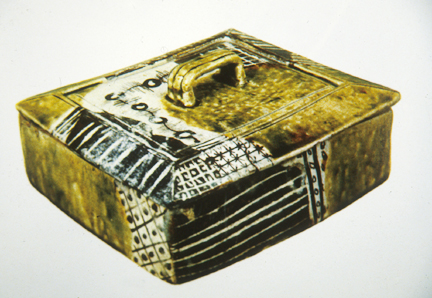
Painted Oribe Covered Box, Stoneware with copper green glaze and iron oxide painted decoration
Japan, Momoyama Period, 1568-1615 CE
ART 198 - HISTORY OF WORLD CERAMICS
| Also produced at Mino since the Momoyama for tea ceremony use is Oribe Ware. Covered ceramic boxes were used to hold the small kaiseki meal that would accompany the tea ceremony. Named after the celebrated tea master, Furata Oribe, this ware is a favorite for cha-no-yu, or the way of tea. Depending on the season, different types of ware are preferred for use in the ceremony. Oribe ware differs from much tea ceremony ware in that it is actually painted. The shapes of Oribe ware are eccentric as well, taking on geometric forms such as the square, rectangle, oval, fan, and hexagon, and often hand built. This covered box is representative. This type of Oribe is called Green Oribe, and is the most common type. The glazing of Green Oribe follows a prescribed formula: Two areas of copper green glaze are applied, opposite each other and framing an area of clear glaze on the light stoneware. In this light area, geometric and repeating patterns are painted in a dark brown to black iron oxide. | Painted Oribe Covered Box, Stoneware with copper green glaze and iron oxide painted decoration Japan, Momoyama Period, 1568-1615 CE |
|
|